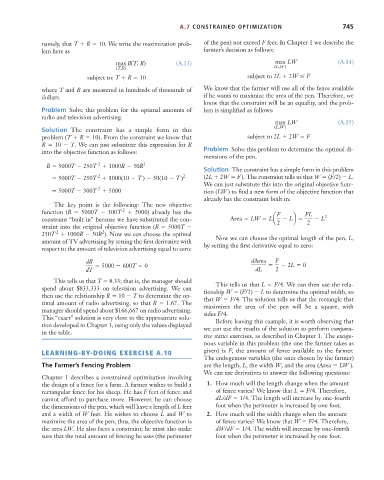Page 771 - Microeconomics, Fourth Edition
P. 771
BMappAMathematicalAppendix.qxd 8/17/10 1:10 AM Page 745
A.7 CONSTRAINED OPTIMIZATION 745
namely, that T R 10. We write the maximization prob- of the pen) not exceed F feet. In Chapter 1 we describe the
lem here as farmer’s decision as follows:
max B(T, R) (A.13) max LW (A.14)
(T,R) (L,W )
subject to: T R 10 subject to 2L 2W F
where T and R are measured in hundreds of thousands of We know that the farmer will use all of the fence available
dollars. if he wants to maximize the area of the pen. Therefore, we
know that the constraint will be an equality, and the prob-
Problem Solve this problem for the optimal amounts of lem is simplified as follows:
radio and television advertising.
max LW (A.15)
(L,W )
Solution The constraint has a simple form in this
problem (T R 10). From the constraint we know that subject to 2L 2W F
R 10 T. We can just substitute this expression for R
Problem Solve this problem to determine the optimal di-
into the objective function as follows:
mensions of the pen.
2
B 5000T 250T 1000R 50R 2
Solution The constraint has a simple form in this problem
2
5000T 250T 1000(10 T ) 50(10 T ) 2 (2L 2W F). The constraint tells us that W (F/2) L.
We can just substitute this into the original objective func-
2
5000T 300T 5000 tion (LW ) to find a new form of the objective function that
already has the constraint built in:
The key point is the following: The new objective
function (B 5000T 300T 2 5000) already has the F FL
constraint “built in” because we have substituted the con- Area LW L a 2 Lb 2 L 2
straint into the original objective function (B 5000T
2
2
250T 1000R 50R ). Now we can choose the optimal
Now we can choose the optimal length of the pen, L,
amount of TV advertising by setting the first derivative with
by setting the first derivative equal to zero:
respect to the amount of television advertising equal to zero:
dB dArea F
5000 600T 0 2L 0
dT dL 2
This tells us that T 8.33; that is, the manager should This tells us that L F/4. We can then use the rela-
spend about $833,333 on television advertising. We can tionship W (F/2) L to determine the optimal width, so
then use the relationship R 10 T to determine the op- that W F/4. The solution tells us that the rectangle that
timal amount of radio advertising, so that R 1.67. The maximizes the area of the pen will be a square, with
manager should spend about $166,667 on radio advertising. sides F/4.
This “exact” solution is very close to the approximate solu- Before leaving this example, it is worth observing that
tion developed in Chapter 1, using only the values displayed we can use the results of the solution to perform compara-
in the table.
tive statics exercises, as described in Chapter 1. The exoge-
nous variable in this problem (the one the farmer takes as
LEARNING-BY-DOING EXERCISE A.10 given) is F, the amount of fence available to the farmer.
The endogenous variables (the ones chosen by the farmer)
The Farmer’s Fencing Problem are the length, L, the width W, and the area (Area LW ).
We can use derivatives to answer the following questions:
Chapter 1 describes a constrained optimization involving
the design of a fence for a farm. A farmer wishes to build a 1. How much will the length change when the amount
rectangular fence for his sheep. He has F feet of fence and of fence varies? We know that L F/4. Therefore,
cannot afford to purchase more. However, he can choose dL/dF 1/4. The length will increase by one-fourth
the dimensions of the pen, which will have a length of L feet foot when the perimeter is increased by one foot.
and a width of W feet. He wishes to choose L and W to 2. How much will the width change when the amount
maximize the area of the pen; thus, the objective function is of fence varies? We know that W F/4. Therefore,
the area LW. He also faces a constraint; he must also make dW/dF 1/4. The width will increase by one-fourth
sure that the total amount of fencing he uses (the perimeter foot when the perimeter is increased by one foot.

